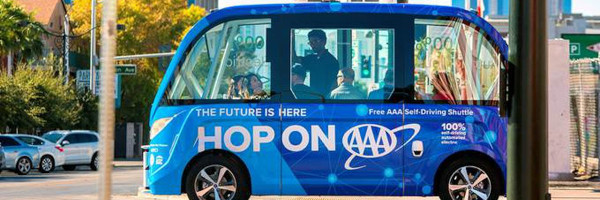GENIVI Las Vegas Connected Vehicle Pilot Project
| GENIVI Las Vegas Connected Vehicle Pilot Project | |
|---|---|

| |
 Las Vegas Connected Vehicle | |
| Team Organizations | GENIVI Jaguar Land Rover Volvo Cars] HARMAN International Hortonworks |
| Team Leaders | Joanna Wadsworth of the City of Las Vegas |
| Participating Municipalities | Las Vegas Nevada |
| Status | Launched |
| Document | None |
Description
The GENIVI Alliance, the Nevada Center for Advanced Mobility (Nevada CAM), the City of Las Vegas (CLV), the Regional Transportation Commission of Southern Nevada (RTC), and the University of Nevada, Las Vegas (UNLV) have partnered on a Connected Vehicle Pilot with a focus on pedestrian safety and traffic flow. CLV and RTC fleet vehicles are being outfitted with new technology utilizing GENIVI Alliance Remote Vehicle Interaction software that will allow the driver to receive information regarding road conditions, including crosswalk and bus stop locations, from city data on an infotainment platform. In essence, the vehicle will be sent messages based on its location in relation to city data to alert the driver that they may be approaching a location with the potential for high-pedestrian activity or that adverse traffic conditions are ahead on their route, creating a safer and more connected transportation network.
Challenges
- Address roadway safety for all users and prevent crashes due to distracted driving
- Clark County has one of the highest pedestrian fatality rates in the nation
- Ease of access to real-time and robust historical data that may provide insight into roadway operating conditions and crash investigation
Solutions
- Use connected car technologies to provide actionable messaging to drivers on road conditions
- Adoption of an open standard vehicle communication protocol based on a consortia-developed technology enabling faster deployment among vehicle manufacturers
- On-board diagnostic port data could be collected for big data analytics for city planning and decision-making purposes=Major Requirements=
- Identify roadway safety use cases that could be addressed using the connected car technologies
- Develop and deploy an in-vehicle unit that consistently gathers vehicle data from and displays information in a variety of makes/models in the city/regional fleet
- Establish secure, reliable, two-way wireless connectivity between the in-vehicle unit and city-hosted servers so that vehicle data flows and actionable alerts return to inform the driver
- Identify city infrastructure datasets that could interface with the vehicle data for messaging on static roadway features
- Identify fleet vehicles and/or personal vehicles to be outfitted with the in-vehicle, on-board units with the communication devices
- Deploy “big data” tooling to combine vehicle data with existing static and dynamic transportation data resulting in actionable messages to alert drivers of specific hazards (speeding, high pedestrian zone, bus unloading ahead, congestion ahead)
- Develop analytics and trend reports that support city/region/state transportation planning decisions for the welfare of citizens and visitors
Major Requirements
Performance Targets
| Key Performance Indicators (KPIs) | Measurement Methods |
|---|---|
|
|
Standards, Replicability, Scalability, and Sustainability
- Project deploys and tests a draft, open concept produced by the GENIVI Alliance that enables vehicles of any make/model to securely exchange information with servers and other transportation entities, such as infrastructure and vehicles
- Big Data tooling is based on Hadoop, an open-source, licensed technology used in many industry contexts, including cities and government
- City/Region data is based on broadly adopted geospatial standards
Cybersecurity and Privacy
Not Yet Available
Impacts
- Describe the anticipated economic benefits (new products, jobs, economic growth, exports, contributions to the tax base, etc.) as well as impacts on energy, health, safety, environment, or other quality of life aspects.
- Safer driving experiences by participating drivers
- Valuable data for analysis and use for transportation policy and decision-making on infrastructure enhancements that increase pedestrian safety and reduce traffic congestion
Demonstration/Deployment
- Approximately 1/3 of total available vehicles will be equipped with in-vehicle units and two of four safety-related scenarios deployed
- First quantitative reports showing impact of alerts on driver behavior compiled and metrics determined